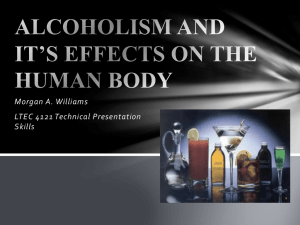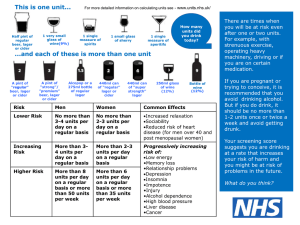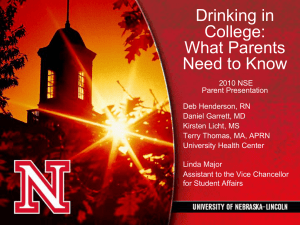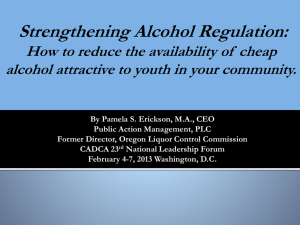Everyday drinking: The meaning of alcohol for working age drinkers
advertisement
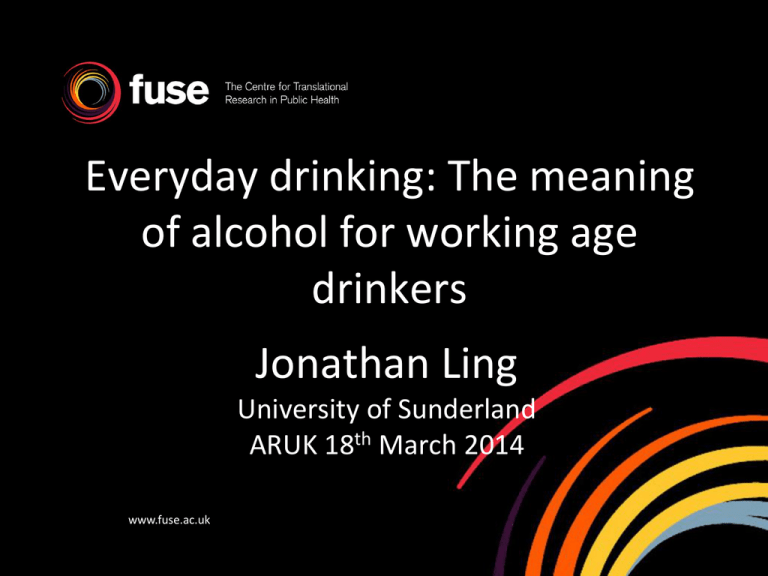
Everyday drinking: The meaning of alcohol for working age drinkers Jonathan Ling University of Sunderland ARUK 18th March 2014 www.fuse.ac.uk Alcohol 1. Why alcohol? • Leading risk factor for premature mortality, disability and loss of health in the Americas and the second largest in Europe (WHO, 2013) • Significant burden on society – health, social costs…. Most drinkers are sensible? • But alcohol use outside socially defined acceptable parameters is viewed negatively and is also strongly associated with illness and crime 2. Why middle aged (and older)? Public health policies focus on young people, binge drinking, problematic drinkers and the socially visible consequences of • Disregard harmful health and social effects of average alcohol consumption over time UK alcohol strategy does acknowledge the health impact of alcohol use • But focus remains on “turn[ing] the tide against irresponsible drinking” • though this is narrowly defined in PH…. Alcohol-related death rates for 35-54s have more than doubled since 1991 • Reasons – drink driving, off sales, changing drinking culture But alcohol use outside socially defined acceptable parameters is viewed negatively and is also strongly associated with illness and crime Evidence indicates that drinking inside the socially acceptable parameters is causing problems too.... 3. Middle aged, middle class Households with an adult working in managerial/ professional role: • have highest proportion of alcohol consumption in previous 7 days • more likely to have had an alcoholic drink on 5 or more days in the previous week (NHS, 2012) Shift from drinking in pubs to home drinking How is alcohol consumption viewed by this group? Perceptions of harmful use as ‘the other’ Unacceptable or problematic use associated with longterm, heavy or binge drinking • I know what you mean, yeah, drinking to excesswhen you see these young teenagers on the streets can’t walk, sort of like collapsed in a heap cos they've drank that much Distinctions made between own use and others’ by broadly constructed stereotypes Drinking seen as a coping mechanism, or outside their own peer group such as ‘young people’ • The people who are predominantly doing it [drinking problematically] are in a society and a culture where it just becomes the norm; they don’t know any different - they can’t get out of it - but then you are moving into a situation where you are looking at far more than just the alcohol side of things. Normalisation of use when seen as controlled/harm free No connection made between personal behaviour & current public health messages or potential health risks • Just speaking for myself, I am fully aware of all the information and fully aware of what I should be doing and what I shouldn’t be doing and how I should drink and when I should drink, but I am making a choice. I've seen all the education, I don’t think I drink excessively but if you put me on a scale according to the Government I am off the scale but, I feel fit, healthy.... Drinking was a socially acceptable form of relaxation, marked a transition from work or parental responsibilities, to ‘me time’ I drink one, because I've had a stressful day at work, two because I've had a stressful day at home. Ability to function as an endorsement of acceptable use Functioning at work and acting responsibly considered indicators that drinking remains within acceptable levels I think more people care about what they look like on the outside than the inside so if you are not putting a lot of weight on I don’t think people care that much unless you start weeing blood or something. There was also some scepticism about the limits.... • Well it's been discredited anyway hasn’t it recently, because I mean the last thing I read about units etc., is that this man had just decided all by himself what a unit was and that then became the recommended guidance. So really it wasn’t backed up by anything particular, it was just this bloke thought 'that sounds about right' and after that it was given out as recommended guidance. In other words: • regular (sometimes every night) drinking at home seen as moderate and unproblematic • ability to function at work was seen as evidence that drinking was within safe limits and them causing no harm • public health advice about limits ignored Future public health messages should Focus less on crime and personal safety Be more sensitive to lifestyles and long-term health risks But what do we mean by lifestyle? What is the relationship between lifestyle and alcohol use for those in mid-life? 4. Alcohol and culture Brierley-Jones et al. (in press) Alcohol has an established place within British culture • Socialising, pleasure, celebration and escape from pressure Choice of drink has meaning…. • Beer/lager/spirits = sociability/having fun • Wine = sophistication/success/refinement/moderation Examined alcohol use using Bourdieu's concepts of habitus, field and capital Particularly interesting for the middle classes who have obtained 'distance from necessity' Therefore consumption and other behaviours become symbolically marked The choices we make have a meaning Examining associations could help clarify/target health messages: • …[my husband and I]… cook a nice meal, have a nice glass of wine, and earlier in the week when we try not to drink so much or at all, we have to have more basic meals, because to me a nice meal just goes with a nice glass of wine. Drinking is laden with meaning Not just what, but where.... Two styles (habitus) of consumption emerged: Home Traditional Focus on former habitus today Traditional is well-documented; forms basis for current harm reduction strategies But home drinking now widespread (Emslie et al., 2011; Foster et al., 2010) Home drinking has major public health implications • I think you probably drink more if you are at home simply because you haven't got the chew of going up to the bar [….]. At home you just, I would presume, just sit with the bottle next to you. • We know couples who go through a bottle of wine quite easily after the children are in bed. • I definitely have a drink [of wine] when I come in from work because, I think, I do sort of deserve that. It's my time. The bin of shame Wine has a transformative capacity There's nothing nicer than sitting down on a night time when you've finished work with a nice glass of wine and it works both ways. In winter time you can draw the curtains and you think 'Oh, this is lovely' and put your feet up with a glass of wine. And in summer time you're sitting out in the sunshine and you've got a nice cold glass of wine. So, you know, it's social isn't it? But behaviour is related to context/social networks • But I drink differently as well, if I go out with [partner] we will have a few drinks but don’t ever get absolutely shit faced but if I go out with the girls I go out with the aim that I will drink until I am sick…. Implications for PH 1. Current messages are currently aimed at traditional but not home drinkers 2. Home drinking, particularly wine, is a means of distinction and a source of cultural capital, which will make it resistant to change 3. Minimum pricing may be ineffective for higher socioeconomic groups as scarcity may increase wine’s symbolic value 4. Some PH messages are starting to change…. Acknowledgements Karen McCabe, Lyn Brierley-Jones, Graeme Wilson, Ann Crosland, Eileen Kaner & Katie Haighton The work was undertaken by Fuse, a UKCRC Public Health Research: Centre of Excellence. Funding from the British Heart Foundation, Cancer Research UK, Economic and Social Research council, Medical Research Council, and the National Institute for Health Research, under the auspices of the UK Clinical Research Collaboration, is greatly acknowledged. Opinions expressed in this presentation do not necessarily represent those of the funders.



